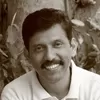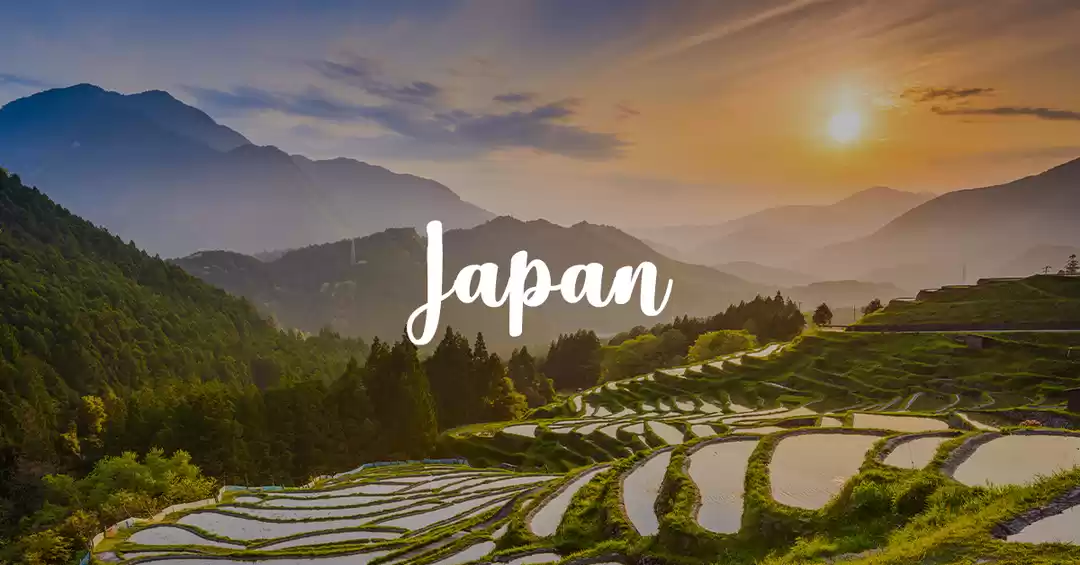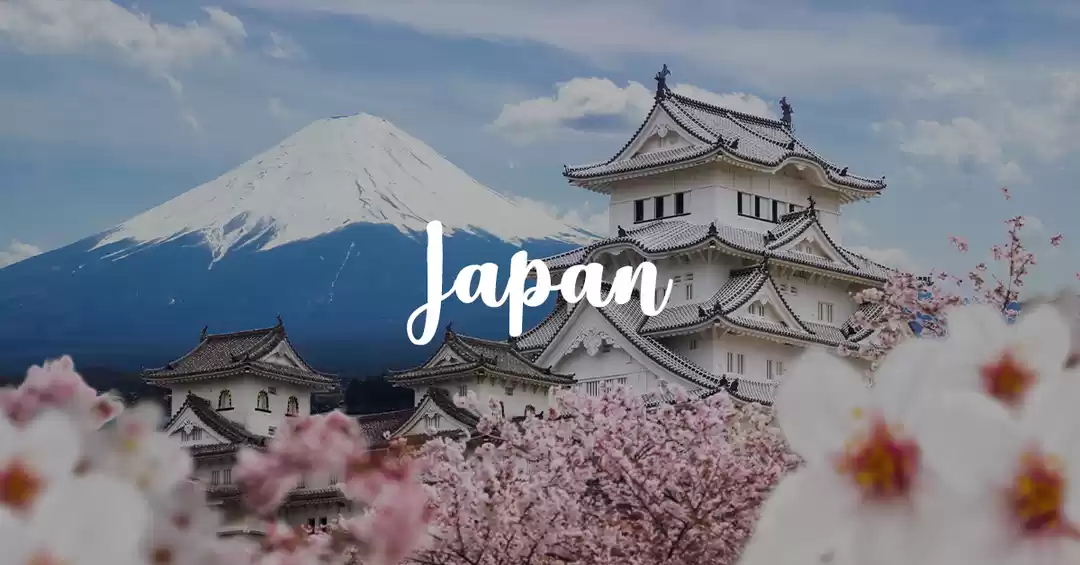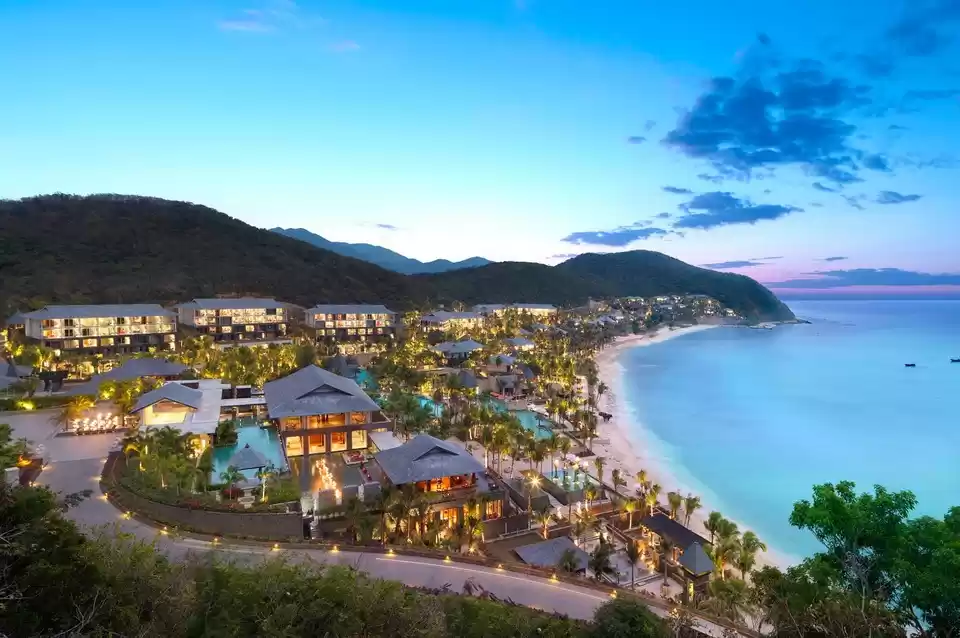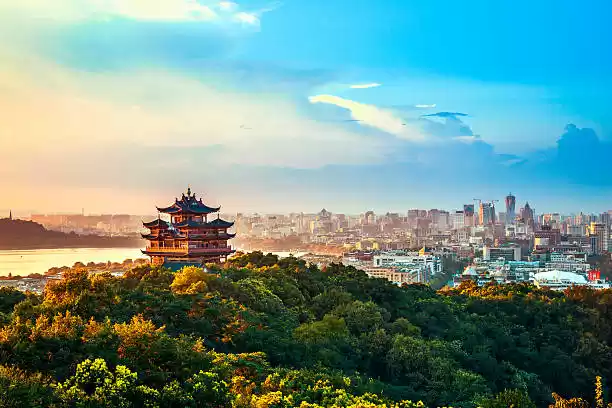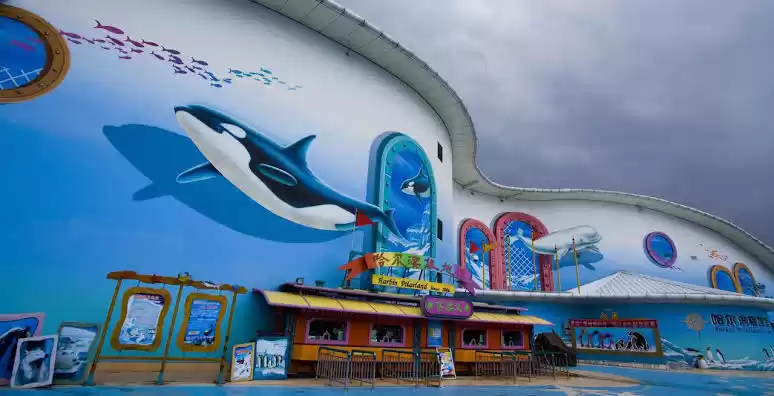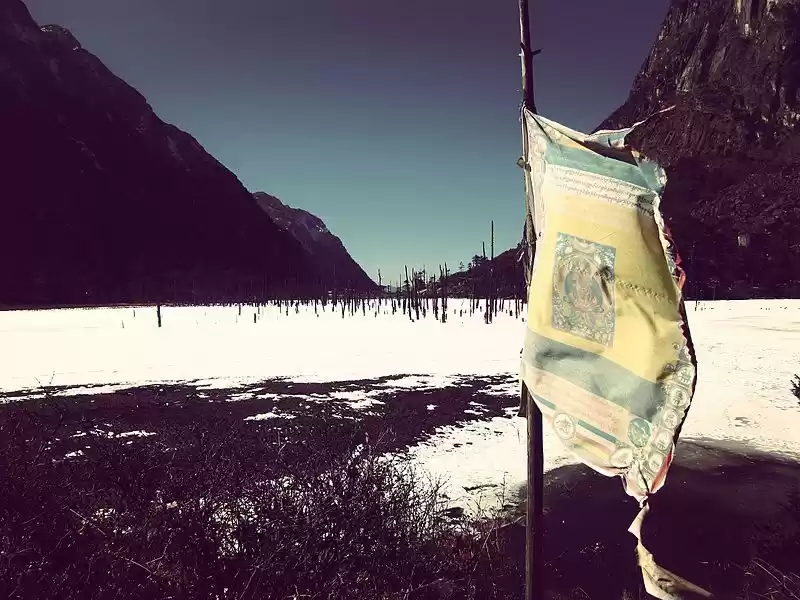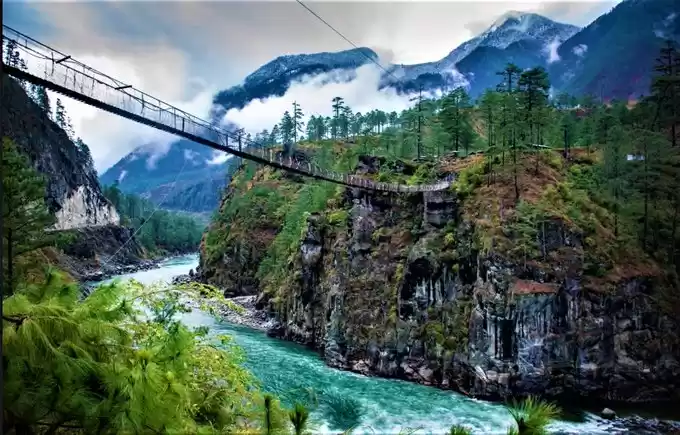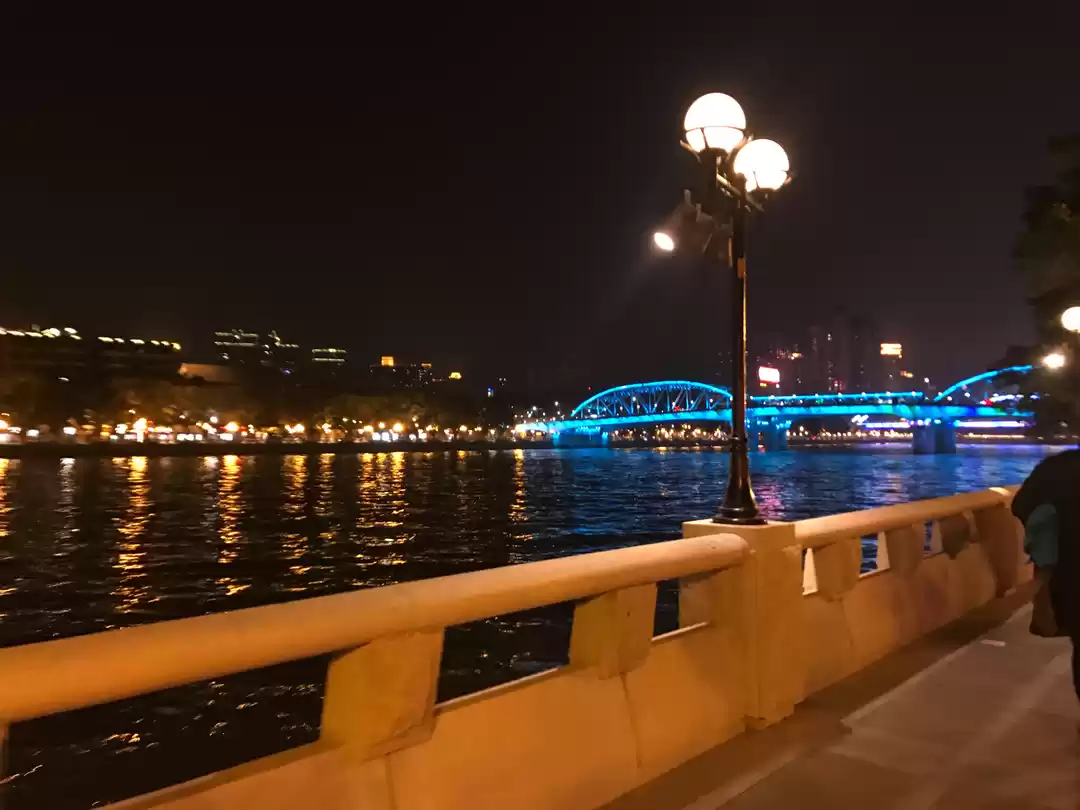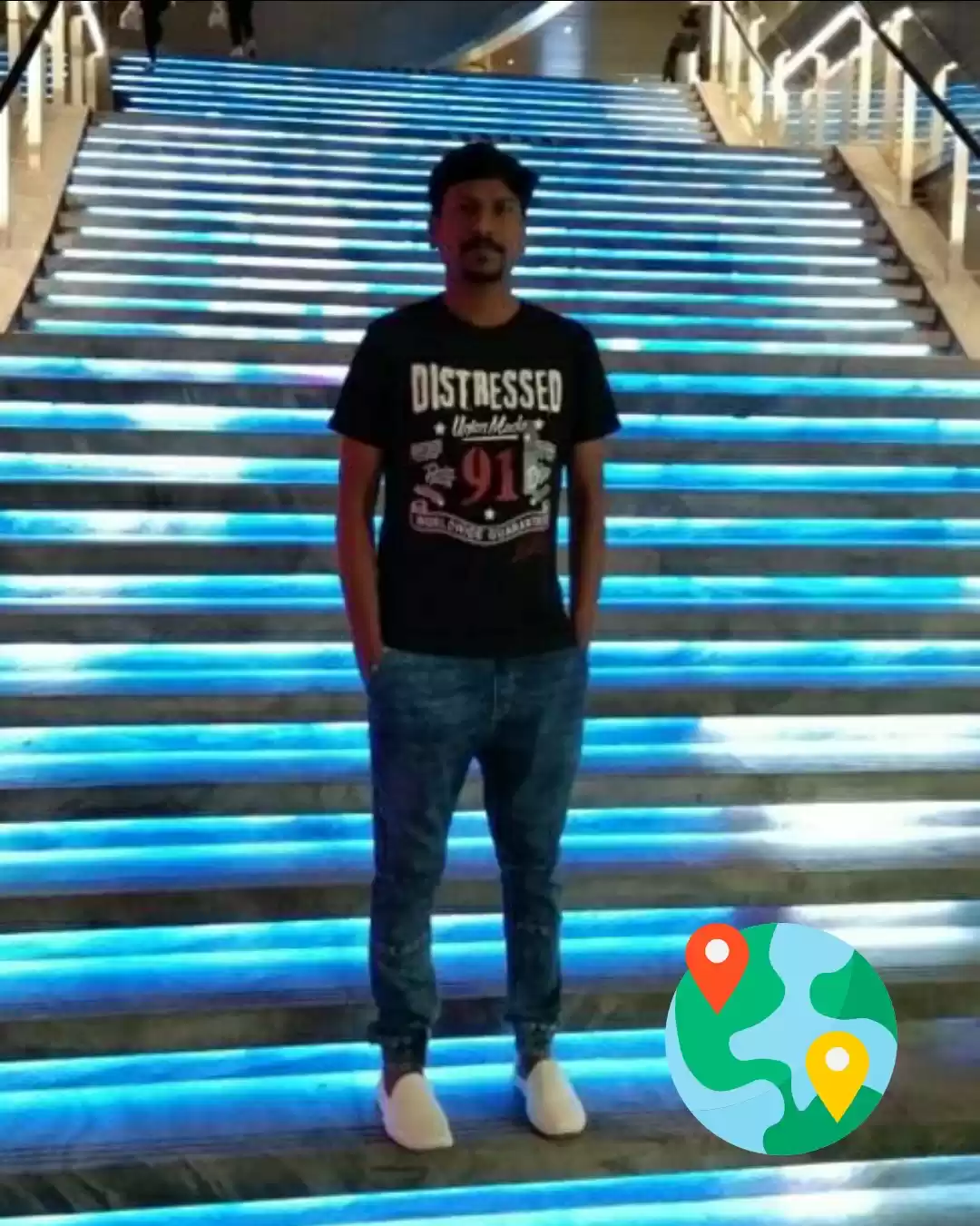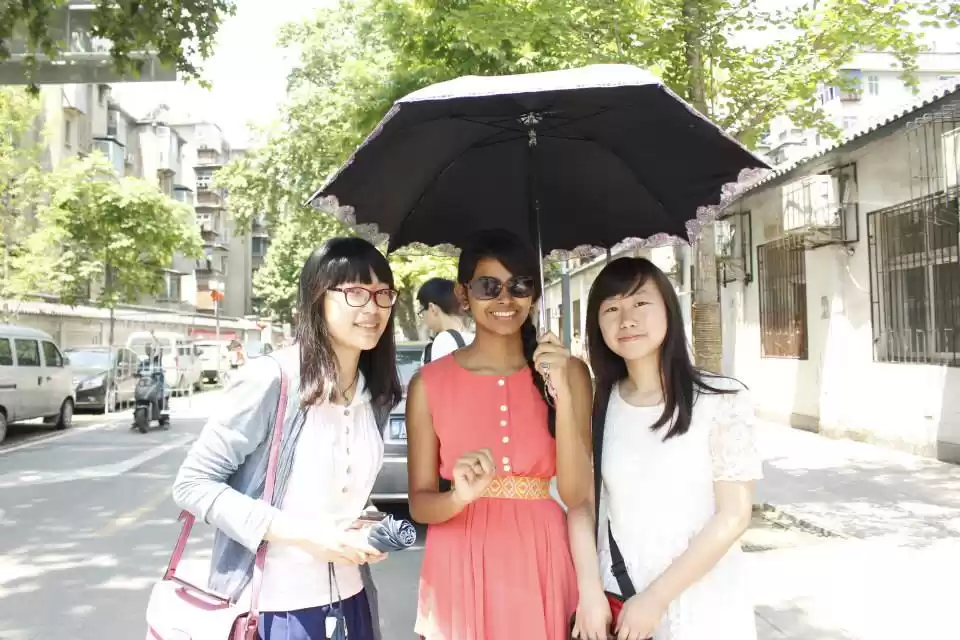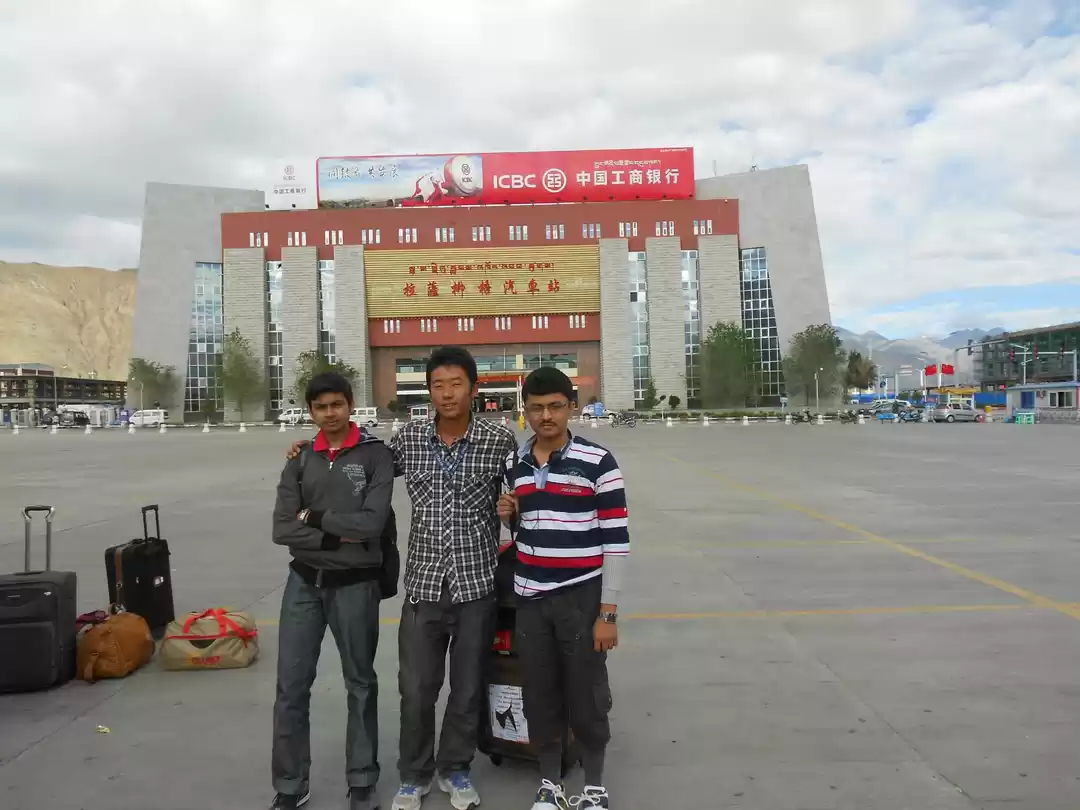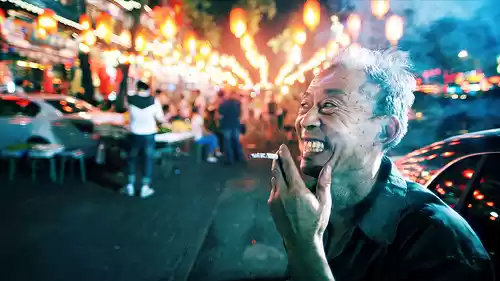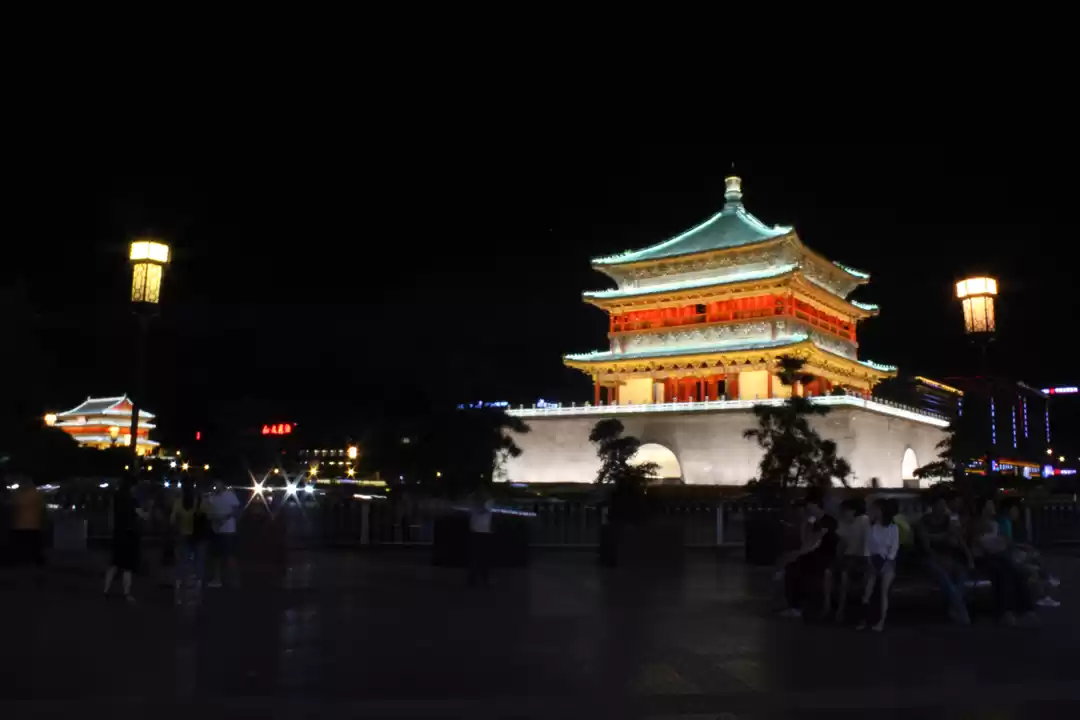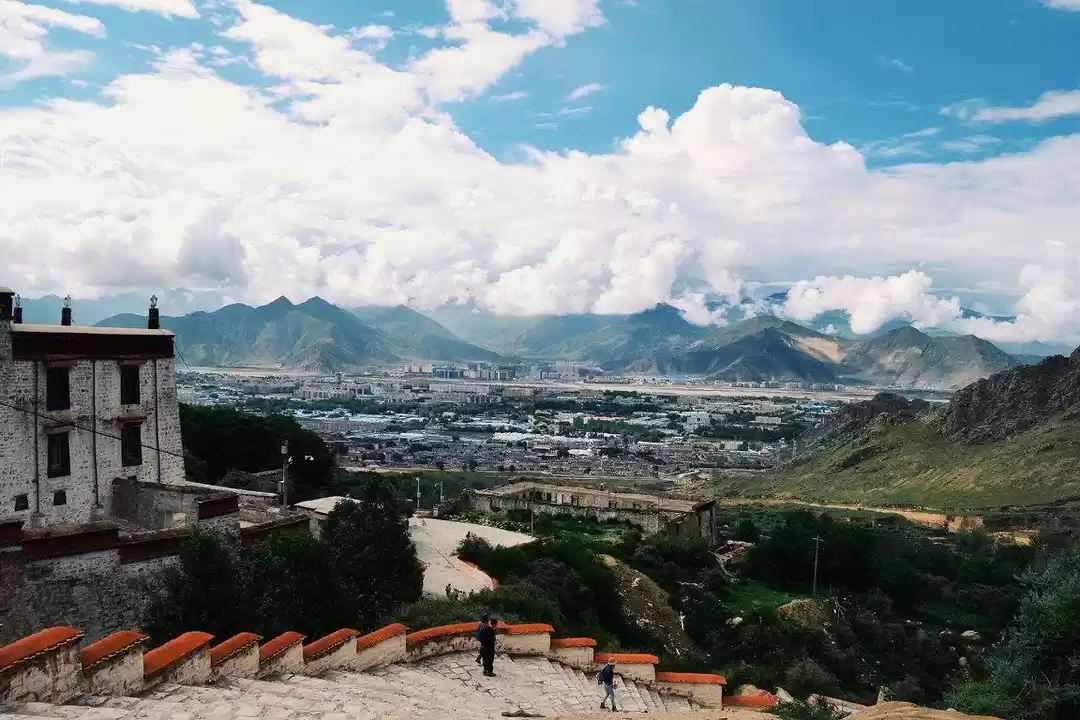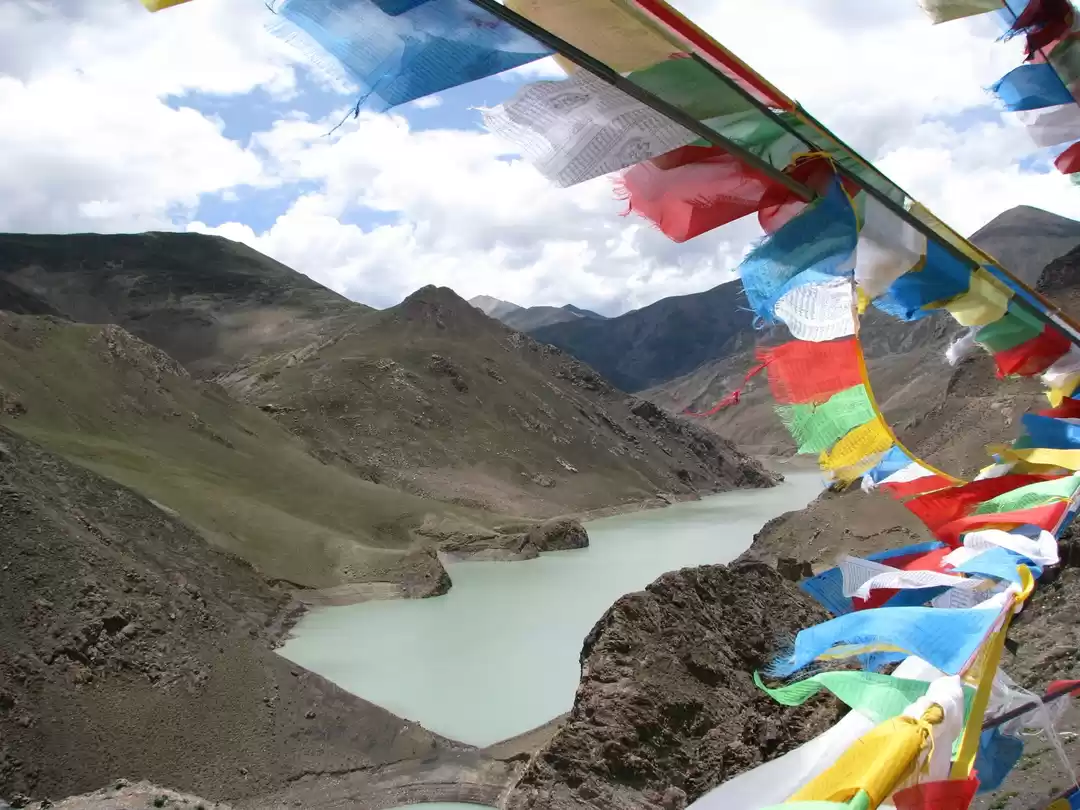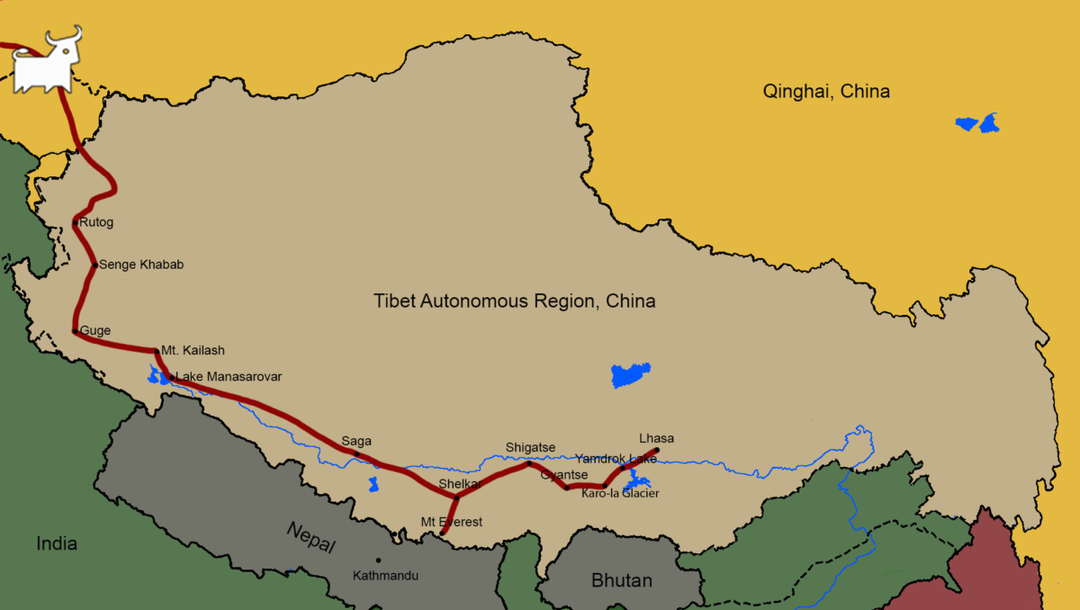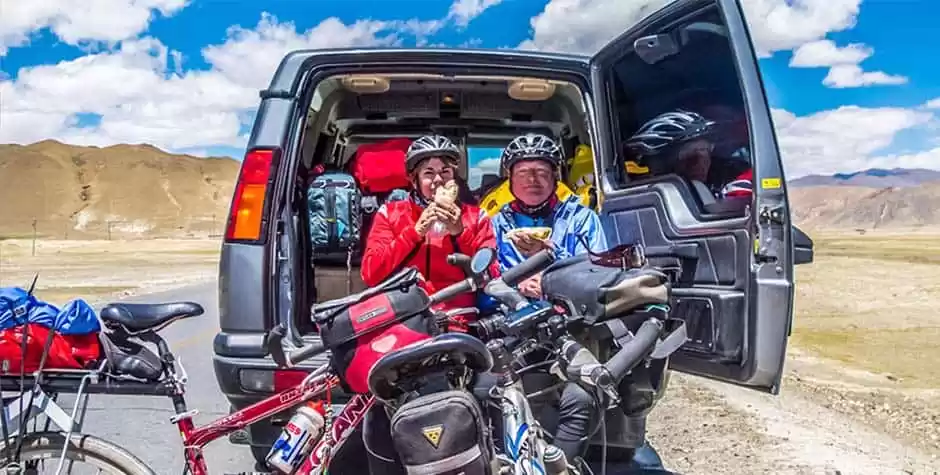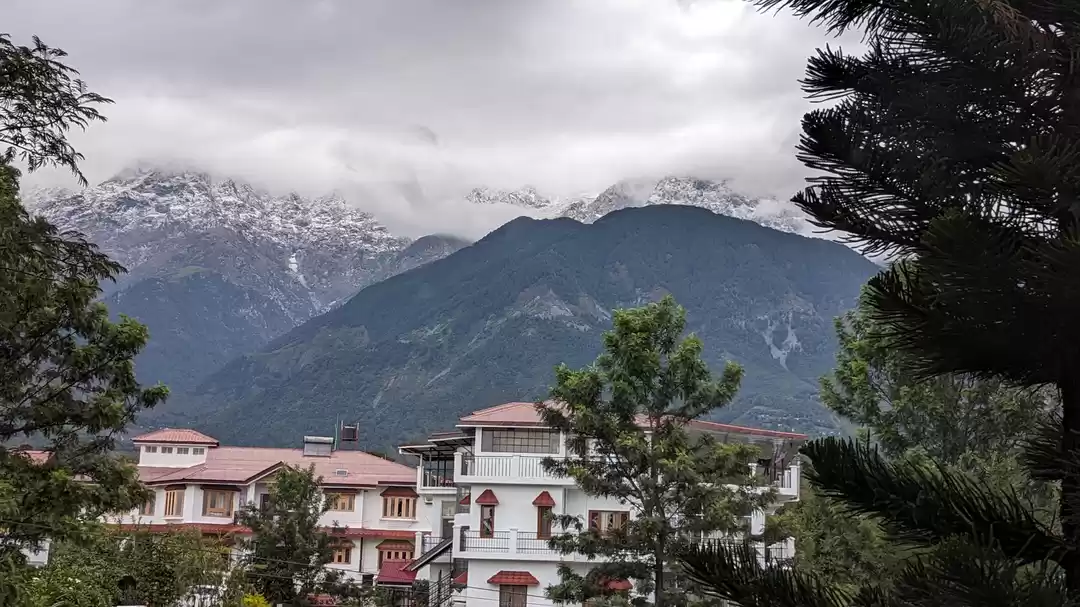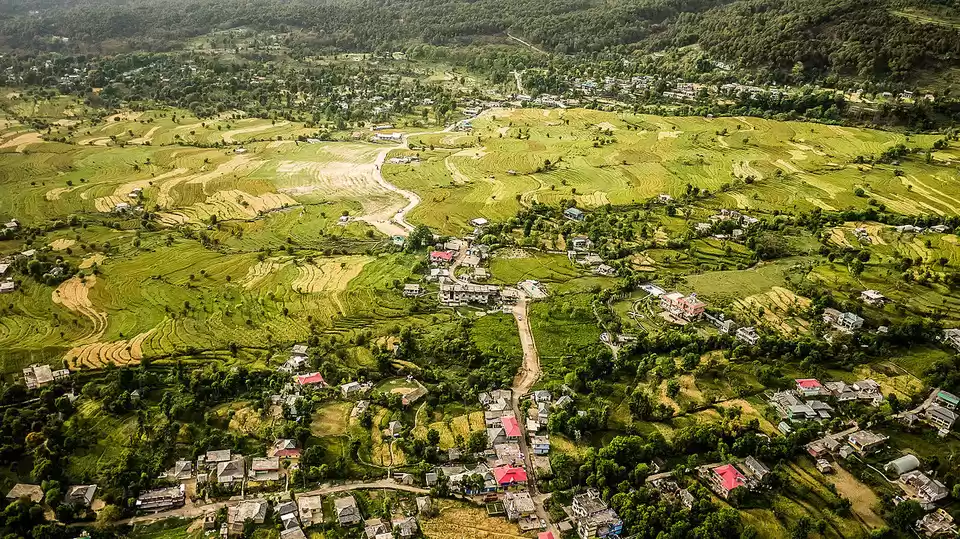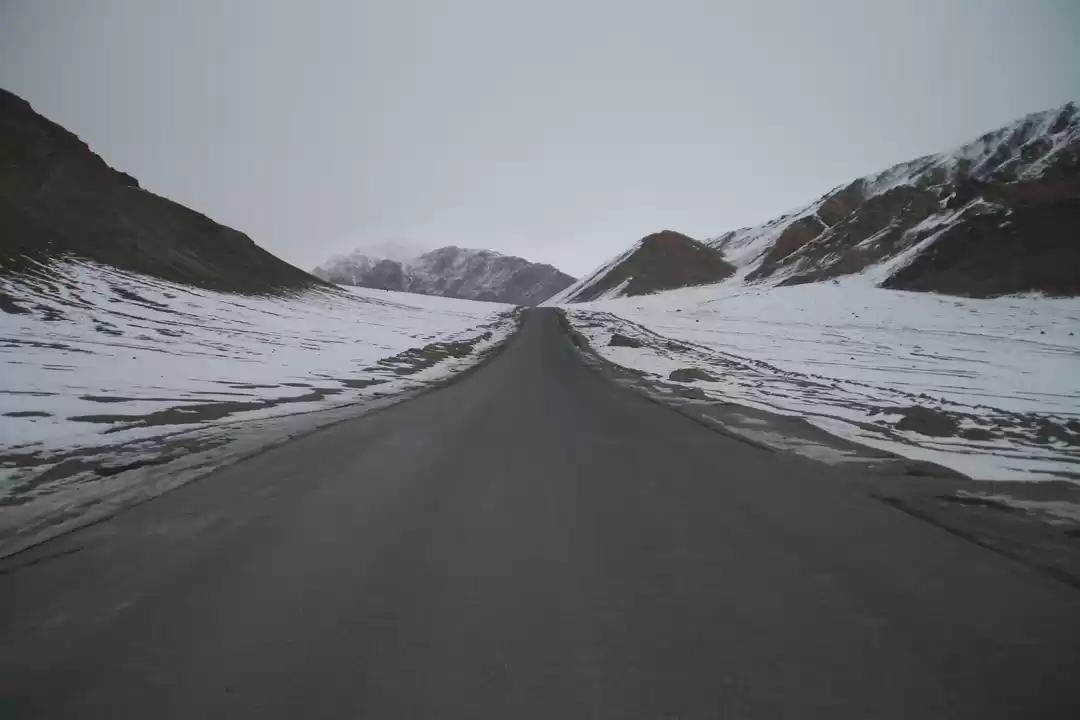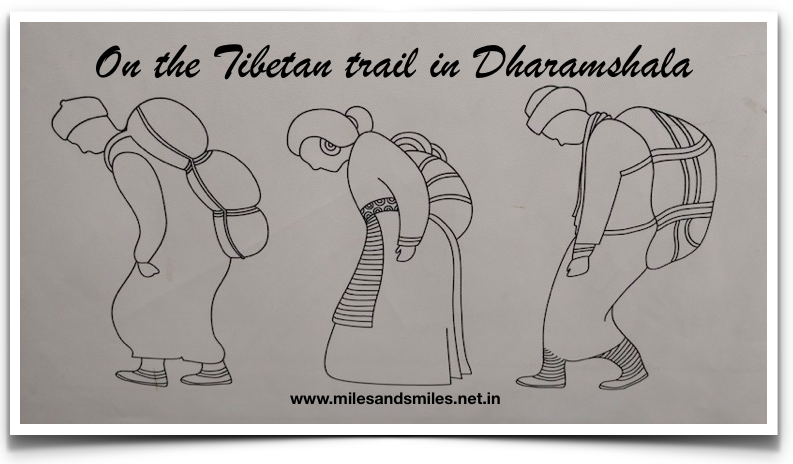
It was the National holidays time again and I was restless to make the best use of it. The inquiries started couple of months earlier. I was keen in going to a newer place, preferably Tibet, Yunnan or Xinjiang. I kept checking with FCN, CET and few other travel groups, but nothing was coming through. We finished our India trip in September. Kavya, our daughter also came to Beijing with us for a short vacation. I started pursuing again and the FCN boss Liang Chen responded that though they don't have a trip to any of these places, he can help us with another company. He asked Evelyn to help us and Evelyn created a WeChat group with another person Xiaotuo. It was decided that we will have a Tibet tour.
Before I start my travelogue, for those who may be unfamiliar, let us have at an introduction to Tibet.
Tibet (西藏, xī zàng) autonomous region (TAR) is one of the western provinces of the People's Republic of China. Due to its high altitude, it is also called the 'Roof of the World' and the 'Third Pole of the Earth'. It has the world's highest peak, the splendid Mount Everest (Qomolangma, 8848m), and the Tibetan Plateau, where the Yangtze River and Yellow River both begin. Tibet also boasts of the mysterious Mount Kailash (Gangdise Mountains, Meru Parvat, 6718m), a famous pilgrimage of Hindus, Buddhists and Jains which is the birthplace of for major rivers: Yarlung Tsanpo (Brahmaputra), Mapcha Tsangpo (Karnali/Ganges/Ganga), Langchen Tsangpo (Sutlej) and Senge Tsangpo (Indus/Sindhu). Mount Kailash is considered as the holy abode of Lord Shiva and is currently thought to be unconquered. It advised not to climb the mountain, since that would be sacrilege and cause misfortune. Mount Kailash's rare shape has led to the theories that perhaps the mountain is a manmade pyramid.
Though TAR is the second largest province in China, its population is not dense. In an estimated 6 million Tibetans, only around 3.18 million live in Tibet. The history of Tibet is about 4,000 years old, when Buddhism and Zhang cultures met. The major religion of Tibet is Tibetan Buddhism, and around 80 percent of the Tibetans within the TAR are Buddhists. About 12% of the population of Tibet follow the ancient Bon religion. In history, there have been conflicts between the two religions, but Buddhism has grown stronger. Tibetan Buddhists have unique practices like pilgrimage prostration and different burial practices. To learn more about the six major burial practices, please see my earlier blog: https://china-diary.com/2018/05/16/journey-to-qinghai-and-gansu-visiting-very-beautiful-qinghai-lake-and-colorful-danxia/
People use both Tibetan language and Mandarin. Most Buddhist texts are in Tibetan Language, the script of which is more like Devanagari. The creation of the Tibetan alphabet is generally credited to Thonmi Sambhota, a minister of Songtsen Gampo. It is said that he went to India to study the art of writing Sanskrit.
Foreigners need special permit for entering Tibet and there are many checkpoints along the way to make sure that the travelers are legal.
Coming back to our preparations now. As it was late, train journey was ruled out. They also helped me to get the flight tickets at reasonable prices. The onward flight was on 1 st and return was on 7 th. After a few days, we learnt that the flight on 1 st was cancelled and they rebooked for 30 th September afternoon. I provided our passport details and address to Xiaotuo for applying the permit to Tibet. We got the permit by courier on 27 th September. Xiaotuo shared a Tibet itinerary that looked great. The idea of visiting the Everest base camp made us excited. He gave the weather information and the name of the person who would receive us at Lhasa. His name was Ngawang.
We flew by Tibet airways 2:55 flight. The plane was an Airbus 330. They served reasonable food, tea and biscuits. The flight landed at 6:50. When we came out after collecting our bags, Ngawang was waiting for us at the arrival gate. He welcomed us with traditional Tibetan silk shawl and took us to a van in which there were other people. He gave us a slip that had the guides name and the time of meeting him at the hotel lobby (9:00). The journey from airport to hotel took over 1 hour. We checked into the hotel. The Tibet Gang gyan hotel, Lhasa, a four-star hotel on the main street of Beijing road, appeared to be old, but luxurious. We saw later that the hotel had a major traffic signboard too! After freshening up, we came out and had dinner of dumplings and mixed vegetables in a nearby restaurant.

Day 1, 1st October, Lhasa: Next morning, we had breakfast at the hotel's restaurant and met our guide Phurbu Tsering at 9:00. He was a young Tibetan man. He said his name meant Thursday (Phurbu) and long life (Tsering) as he was born on a Thursday. Interestingly, Phurbu or Phurba is also Tibetan dagger. The tour operator for our trip was Tibet Vista, and there were 8 other people, some with different itineraries, in our group. People were from Japan, Germany, Italy, Australia, Malaysia, Singapore and China, most of them working in China. We had a 15-seater vehicle for us.
Lhasa (拉萨, lā sà) is the beautiful capital city of Tibet Autonomous Region (TAR) situated in on the North bank of the Kyichu ( Lhasa happiness) River in a valley surrounded by mountains. In the Tibetan language, Lhasa means the "Holy Land" or the "Buddha Land". It is the center of Tibet's politics, economy and culture. Known as Sunlight City, at an altitude of 3,658 meters, it is the highest city in the world.
We left the hotel at 8:45. Full team of 13 people was there in the van. The first spot of the day was Drepung Monastery, the largest monastery in Tibet. We reached the place at 9:30. At the entrance was a big fire place. People bought juniper leaves and barley and burnt them in the fire creating smoke and an intense fragrance. It is supposed to please the spirits. Phurbu started explaining the highlights of the monastery. Drepung Monastery is the most important monastery of Gelugpa in Tibetan Buddhism. It is built at the foot of the Mountain Gambo Utse, in 1416 by Tsong Khapa's disciple Jamyang Qoigy. It held ~10,000 monks in total in its peak time and has about 500 monks now. The name 'Drepung' means 'Collecting Rice' in the Tibetan language as the majestic white structure resembles a heap of rice from a distance.

The education in Tibetan Buddhism is divided into two forms - the Open School and the Secret School. The Secret School is the highest period of learning. Tsong Khapa, founder of the Gelug Sect, preached a combination of the two.
If a lama wants to enter a monastery to study the scriptures, he must first study in the preparatory class of the Open School and then enter the formal class in different grades. If he finishes studying all the scriptures, he is qualified to participate in the examination for the title of Gebshes (Doctor of Divinity). One may obtain different Gebshes titles by passing different examinations. After obtaining a Gebshes title, one may enter the Secret School, where, after choosing a master, one passes through a ceremony named "vessel consecration." Typically, the master pours water from a pot or vase onto the head of the disciple, and then offers him wine from a bowl made of a skull to warn him to clear his mind of all evil thoughts. After this ceremony, the master starts to teach the disciple the scriptures. The disciple will undergo the ceremony of "vessel consecration" every time he moves to a higher level of the Secret School. Students receive instruction four times a day, sitting on a seat paved with sharp pebbles until he obtains the title of Living Buddha.
Phurbu also explained the concept of Dalai and Panchen Lamas, who are treated as living Buddhas. The Dalai Lama is supposed to be the embodiment of Avalokitesvara (Bodhisattva of compassion), and the Panchen Lama is said to be the embodiment of 'Amitabha', the Buddha of Infinite Life. The title "Dalai Lama" was given by Mongol king Altan khan, to the third, and all his successors are called as Dalai Lama. 'Dalai', a Mongolian word, means 'Sea.' While 'Lama', a Tibetan word, means 'Master'. The title Panchen Lama is given to all the heads of Tashilhunpo Monastery, starting from number first Dalai Lama because he is the founder of Tashilhunpo Monastery. 'Pan' is an abbreviation of the Sanskrit word 'pandit,' meaning 'scholar,' while 'chen', a Tibetan word, means 'big'. The combination of the two words means 'master'. Their selection process is unique, where the monks and abbots investigate the holy lake for signs and clues of where the next leader comes from. The present Dalai lama is the 14 th, lives in India and the present Panchen Lama is the 11 th, lives in Beijing.
During 17th century, Panchen Lobsang Choegyen, head of Tashilhunpo monastery became a teacher for both number fourth and fifth Dalai Lama. During number fifth Dalai Lama, Mongol king Gushi khan helped the Dalai Lama to gain political power. Being the teacher for Dalai lama, the Mongol king and Dalai lama gave Panchen Bogodi title to the Panchen Lama and recognized him as number fourth in rebirth. Panchen Lama is also known as Panchen Erdini by the Qing dynasty title.
More details about Dalai and Pancen Lamas can be read here: https://www.britannica.com/topic/Dalai-Lama, https://www.britannica.com/topic/Panchen-Lama
In 1546, the third Dalai Lama was welcomed as the first Living Buddha into Drepung monastery. At the invitation of Mongolia's king, he went to Qinghai Province to preach. He was honored with the title 'the third Dalai Lama'. Drepung Monastery is also the place where the second, third, and the fourth Dalai Lama held the Sitting-in-Bed (enthronement) Ceremony. It was the residence of the fifth Dalai Lama before his nomination by the Qing Dynasty (1644 - 1911).
There are two white pagodas in the center of the monastery and around them are the major buildings: Ganden Podrang, Coqen (Tsochin) Hall, the four Zhacangs (Dratsangs, Tantric colleges), and Kamcuns (dormitory). The Ganden Podrang was built under the supervision of the second Dalai Lama Gendun Gyaco ~ 1530. It was the residence of the second, third, fourth, and the fifth Dalai Lamas. After the fifth Dalai Lama moved to the Potala Palace, it served as the meeting place for the local administration for both politics and religion.

The Coqen Hall is a large Sutra Hall supported by 183 pillars. There are many colorful decorations and murals. There are Thangka paintings like eternal cycle of birth and death (dharmachakra) on the walls of the hall. There are beautiful Manjusri (Bodhisattva of wisdom) and Sitatapatra (female form of Avalokitesvara, the Bodhisattva of Compassion) statues in the middle of the hall. People offer butter to the butter lamps lit in front of the deities. There are also butter sculptures. Water is kept in seven bowls (yonchap) in front of each deity. The offering of water at Buddhist shrines symbolizes the objective to cultivate the virtues of calmness, clarity and purity with our body, speech and mind. It also makes the 'have's and "have not's equal.






Unfortunately, photography is not allowed in these monasteries. This hall also has the stupas of Dalai Lama from second to forth. The second floor has the collection of sutras and the third floor has many precious relic collections.
The view of the city is beautiful from the monastery. Around 12:15, we moved to the next spot, the Sera monastery. Before visiting the monastery, we had lunch at a local restaurant. We chose to have the buffet costing 60RMB.
The main entrance of Sera Monastery is beautiful with painted wooden doorframe and doors. The ceilings are beautifully painted with mandalas (A mandala is a representation of the universe, with different parts of the universe representing different aspects of the Buddhist teachings. A mandala can be a painting, a 3-D model with wood or metal, or a creation with colored sand).

Sera monastery was founded in 1419 by Tsong Khapa's disciple Jamchen Choje Sakya Yeshe. It is at the base of Mount Phurbochok on which Tsong Khapa had built a hermitage called Sera Utse on the ridge above. Sera monastery is one of the three greatest Gelugpa monasteries throughout Tibet, and the other two are Drepung monastery and Ganden monastery. This year in mid of October, the monastery celebrated its 600th anniversary year.
Phurbu said the name Sera is due to wild roses. In Tibetan, Rose is called "Gya Sey" and Yard is called 'Rawa'. So the name means yard of roses. Another theory is that the name is due to the hailstone found during laying of foundation of the monastery, as hail in Tibetan is called Sera.
Legend has it that Tsongkhapa while composing one of his great works saw a page flying, forming a golden letter 'ah' and got dissolved in a stone where the Sera monastery was built later.

During its peak, Sera monastery has over 7000 monks, now there a few hundreds. Like Drepung, Sera also has main hall, colleges and dormitories. The style is different and better preserved.
The 'Tsochin' (Coqen) hall' is the center of religious affairs of the Sera Monastery. It was built by Mongol ruler Gushri Khan. It is a four-story structure where several religious rituals and rites are conducted. The hall is built with 125 pillars and the entrance has columns, painted with colored four heavenly kings. The four heavenly kings are a common sight in all Buddhist temples. The depict the four directions. Two have smiling faces and two of them look fearsome. They are: Vaiśravaṇa (Kubera, one who hears everything), Virūḍhaka (who helps growth), Dhṛtarāṣṭra (The King Who Upholds the Realm. He is known for being protective) and Virūpākṣa (who sees all). Phurbu said that the four guard kings are supposed to come alive at night on certain days of the month. Pictures of the four kings from Jokhang Temple can be seen later in the blog.


The main hall has five chapels in honor of Dipankara (past Buddha), Sakyamuni (present Buddha), Maitreya (future Buddha), Arhats (those who achieved Nirvana), Tsong Khapa, and Kwan-yin (Guanyin, Avalokitesvara with one thousand hands and eleven faces). Maitreya is the largest statue with the future Buddha in a "sitting in chair" position. This is a normal among all the monasteries.

The delicate Gangyur of Tripitaka in Tibetan is the proudest possession of the monastery which now holds 105 out of the original 108 volumes. These priceless volumes, the earliest sutras printed by engraving in China, were presented as a gift to Jamchen Chojey by Chengzhu, a Ming Dynasty Emperor.
There was queue of devotees who had brought their children to seek blessings of Tamdrin or Hayagriva, the horse headed deity, or the protector. Hayagriva is considered as Avalokiteśvara in an angry form. The kids had black mark on their nose, from the butter lamp lights in front of the deity, indicating the blessings of Hayagriva.


Next, we entered a hall where there were three sand Mandalas. Phurbu said that they don't normally keep them for long, but as a special case they have left them. These were like rangolis, very beautiful work of art. One of them was the 13 deity Yamantaka Mandala.

After this, we witnessed one of the most unique events at the Sera monastery, the debates among monks on the Buddhist doctrines are the discussion of Buddhism knowledge. This facilitates better understanding of the Buddhist philosophy to achieve higher levels of study. This debating tradition is characterized by interesting gestures by the participating monks.

This ended our sightseeing for the day. We returned to the hotel and rested for some time. In the evening, Phurbu took all of us for a welcome dinner at a nearby restaurant. The buffet had food close to Indian and the owner knew good Hindi. Hema had headache due to higher altitude and Kujtim, a German engineer in our group offered Acetazolamide tablets. Hema said it worked well.
Day 2, 2nd October, Lhasa: We started early from the hotel as Phurbu said we had the time slot of 9:00 for the Potala Palace. It was a short journey from the hotel. From a distance the Potala Palace looked majestic. There was a queue and we had to wait for about 40 minutes to get in. Phurbu first gave a small proof of buying ticket and later a bid proper ticket.
Potala Palace is the highest palace in the world, supposed to be named after a holy hill in South India. 'Potalaka' is a Sanskrit word meaning "Buddhist holy land, or Abode of the Avalokitesvara". As per a legend, king Songtsen Gampo built a 9-storey palace with a thousand rooms on the Red Hill of Lhasa when he moved the political seat and capital city from Yarlung to Lhasa. As his father was killed when he was 12 years old, he didn't feel safe in old capital city.
With the collapse of the Gampo Dynasty, the ancient palace was almost destroyed in lightning wars. It was later rebuilt by the Fifth Dalai Lama, Ngawang Lobsang Gyatso, during the Qing Dynasty (1644 - 1911) using Tibetan, Qing and Nepali artists. Potala Palace were renovated and extended many times leading to its present form. In 1959, the 14th Dalai Lama left Tibet, and since then, Potala Palace is not the political seat but has remained as the highest cultural heritage of Tibet.

There are two major portions, the Red Palace and the White Palace. The Red Palace is the highest part of the center. It was devoted to Buddhist study and prayer and possesses different halls, chapels, and libraries. It also has smaller galleries and passages. Great West Hall is the largest hall, with beautiful murals painted on its inner walls. There are three chapels around it with the stupa (tomb with relics) of the Thirteenth Dalai Lama Thubten Gyatso (1876-1933) and the statues of Songtsen Gampo, Princess Wen Cheng, and Princess Bhrikuti (from Nepal) inside. The White Palace (Podrang Karpo) was the office building of Tibet local government. This was the residence of Dalai Lama. The Great East Hall was once the site of religious and political events. The fifth and sixth floors are served as the living quarters and offices. The seventh floor has Sunshine halls, the bed room of Dalai Lama.
Potala Palace has other parts with the School of Buddhist Logic, the printing House, gardens, courtyards and even a jail. As the place is at a good height, it also offered a spectacular the view of the city.





To cater to the large crowds, the duration of time in Potala palace is restricted to one hour for the visitors. We came down around 11:30 and walked through the streets to have lunch at the "Lhasa kitchen" restaurant. I chose a set meal while Hema and Kavya tried the kulchas. The taste was very close to Indian food.
After a sumptuous lunch, we proceeded to the second spot of the day, the Jokhang Temple, another important monastery.
Jokhang temple is considered as the "spiritual heart of the city" and the most sacred in Tibet. The entry is through the Barkhor, the market square in central Lhasa. It has a walkway for pilgrims to circumambulate (pradakshina) the temple. Barkhor Square is marked by four stone sankang (incense burners), two of which are in front of the temple and two in the rear. At the open porch in front, many pilgrims offer prostrations.





Jokhang Temple was built in AD 647 by King Songtsen Gampo (AD 617-49), 33 rd king and the first ruler of a unified Tibet, and his two foreign wives who are ascribed with bringing Buddhism to Tibet. The king's first wife, Princess Bhrikuti (married in the 630s), was the sister of the Nepalese king, while his second wife, Princess Wencheng (married in 641), was Chinese princess. It is said that Jokhang was built to house the statue of Mikyöba (Akshobhya) brought by Bhrikuti and Ramoche Temple was constructed for Jowo Sakyamuni (originally from Bodh Gaya) brought by Wencheng. To house the Buddha brought by Princess Wencheng, Later, Jokhang was expanded in to a large complex and the Jowo Sakyamuni statue was also brought here due to safety reasons. Jokhang became the most sacred temple in Lhasa.
As per a legend, the temple is built on a lake bed which was selected after many failed attempts to build a temple in the region. Before this, every time a monastery was built, it would collapse. Confused by this, Princess Bhrikuti asked for Wencheng's help. Being a learned woman, Wencheng told the Princess that the geography of Tibet was very much like a hag, with the lake at the heart. In order to build the monastery, Wencheng advised they must demolish the hag by filling and leveling the lake using 1,000 goats to carry soil from a mountain far away. When the construction work was done, the city around it was called Rasa and the temple, Rasa Thrulnag Tsuklakang ('ra' for goat and 'sa' for earth, and Thrulnag Tsuklakang "House of Mysteries" or "House of Religious Science" in Tibetan,). Later the temple was named 'Jokhang for' or "Temple of the Lord" and the city 'Lhasa", "Holy land".
According to another legend, the king threw his ring into the air, asking the spirits to show him where to build the temple. The ring fell into a lake, from where a stupa emerged. The lake was filled in to support Jokhang Temple, whose central shrine was built over the miraculous stupa.
The Jokhang Temple is a four-story wooden complex with a golden top. It has the architectural styles of the Tang Dynasty, Tibet and Nepal. There is a Dharma Wheel (chakra) flanked by two deer above the main entrance. These represent the Buddha's first sermon, in which he "turned the wheel of the Dharma" in a deer park near Varanasi, India.
The entrance has impressive statues of the four heavenly kings. Paintings showing the building of Jokhang Temple and Buddhism related stories, Dakinis are on the walls of the passage. The statue of Sakyamuni at the age of 12 is in the middle of the hall. It has been gilded many times and decorated ornately with jewels typical of Tibet. When Sakyamuni was alive, he did not agree to be worshipped and did not allow his images to be created. Only three statues, designed by himself, were permitted to be sculpted during his lifetime. The first is an image of him at age eight, the second shows him at age twelve when he was still a prince in India and the third is of him as an adult.





The main hall has two huge statues. To the left is the master Padmasambhava (Guru Rinpoche), the founder of Vajrayana of Tibet. To the right is Maitreya, the future Buddha. By the clockwise, the first chapel has Tsong Khapa and his 8 students, two of which were the first Dalai Lama and first Panchen Lama. A small white pagoda is at the corner. At the south, there are chapels for the Bhaiṣajyaguru (Medicine Buddha), and for the master of Kagyu sect - Milarepa. Milarepa is supposed to be the only person climbing mount Kailash in the 11th century. It is considered auspicious to take his name while doing the circumambulation (pradakshina).

One small chapel has the statue of Guanyin Boddhisattva (Buddha of compassion). On the eastern hall houses the founder of Jokhang Temple - Songtsan Gampo and his two wives Bhrikuti (Tritsun) and Wencheng.
Jokhang temple has innumerable deities. There are also statues for Brahma ( Gyachen in Tibetan), Indra (Tsangba) and Garuda. There a many image of Tara, a feminine form of Bodhisattva. It is also believed that queen Bhrikuti is an incarnation of Tara. According to Buddhist tradition, Tara was born out of the tears of compassion of the bodhisattva Avalokitesvara. It is said that he wept as he looked upon the world of suffering beings, and his tears formed a lake in which a lotus sprung up. When the lotus opened, the goddess Tara was revealed. A similar tradition has White Tara born from the tears of Avalokiteshvara's left eye and the Green Tara born from those of his right. In a third legend, Tara was born from a beam of blue light emanating from one of the eyes of Avalokitesvara. Tara is also the consort of Avalokitshvara. Green Tara, with her half-open lotus, represents the night, and White Tara, with her lotus in full bloom, symbolizes the day. Green Tara embodies virtuous activity while White Tara displays serenity and grace. Together, the Green and White Taras symbolize the unending compassion of the goddess who labors day and night to relieve suffering. [source: "Tara (Buddhist goddess)." Encyclopaedia Britannica Online. 12 Jul. 2010.]
There are also beautiful statues of Maitreya and four armed Avalokitesvara, Amitayus Vijaya (Buddha of longevity) with four faces. One chapel has large statues of nine longevity Buddhas with their consorts in yab-yum positions. Another chapel has the seven Buddhas Vipaśyī, Śikhī, Viśvabhū, Krakucchanda, Kanakamuni, Kāśyapa and Śākyamuni.
There are statues of Atisha and his disciples. Atiśa Dīpaṃkara Śrījñāna was a Bengali Buddhist religious leader. He was one of the major figures in the spread of 11th-century Mahayana and Vajrayana Buddhism in Asia and inspired Buddhist thought from Tibet to Sumatra. There is also an image of Bodhidharma, a Buddhist monk who came from India during the 5th or 6th century and began the physical training of the monks of Shaolin Monastery that led to the creation of Shaolin Kungfu. Another Indian sage Padampa sangye, of 11th century is attributed to moving a mountain next to Everest, is supposed to be the incarnation of the 8th century monk Kamalashīla.

Thus, the Jokhang temple is a treasure house of Buddhist images. Jokhang temple also has living rooms for the Dalai Lamas. Phurbu shared interesting stories of the sixth Dalai Lama, Tsangyang Gyatso. He is known as Chakzampa, the "Iron Chain Maker", Tsöndrü Zangpo "Excellent Persistence", and the King of the Empty Plain. He was also known by a variation of this name, Madman of the Empty Valley. He was a yogi, philosopher, poet, exorcist, teacher, architect, engineer, painter, sculptor, doctor, treasure revealer and a universal genius with supernatural abilities. One day he crossed a river by boat but didn't have money to be given to the boatman. The angry boatman hit him. So, the Dalai Lama decided to create bridges and built many iron chain bridges. He is considered a mind emanation of Padmasambhava and a reincarnation of Dolpopa Sherab Gyaltsen, an ancient Buddhist master. He founded the Iron Chain lineage of the Shangpa Kagyu (Not to be confused with Shangdong Gyalpo, one who built bridge on rivers and founded Tibetan Opera).
There are roumors that as a teenager, Tsangyang Gyatso met a girl named Dawa Zhuoma, the love of his life. He wrote a lot of affectionate love songs for her when they dated. But soon Dawa was taken back to her hometown by her parents and Tsangyang Gyatso never met her again, and he composed even more poems and songs lamenting the relationship. His love songs are popular even now. Phurbu says the love story is not true. He passed away while being taken to Beijing by Mongol king. His tomb is at Kumbum Monastery in Qinghai.
Some of the other chapels have Five Protectors with some fearsome statues of Hayagriva and other protector deities (whose faces are covered with cloth), the Three Kings, Songtsen Gampo, Trisong Detsen and Tri Ralpachen. This room also has the statues of Songtsen Gampo's two wives, ministers and symbols of royalty like elephant and horse.
The first floor also has the Chapel of Samvara. Samvara with four faces twelve arms is in Tantric pose with his consort.
The second floor a rectangular corridor that gives great views of the temple. People like getting photographed with the background of the golden roofs of the temple. We did a group photo here and exited the temple around 14:30. After roaming around the Barkhor street for some time, we returned to the hotel. That evening I walked close to the Potala palace again.





Day 3, 3rd October, Lhasa to Shigatse: We left the hotel at 8:15. The journey started through National Highway G318 that runs between Shanghai and Nepal border at Tibet. There are two routes from Lhasa to Shigatse (Xigaze). While going, we took the longer route that has more scenic views. As the vehicle moved through winding mountain roads, we could see ladders drawn on the rocks, understandably with the intentions of connecting with the heaven. There are speed cameras on the highway, and one can not cross two speed cameras in less than certain amount of time.
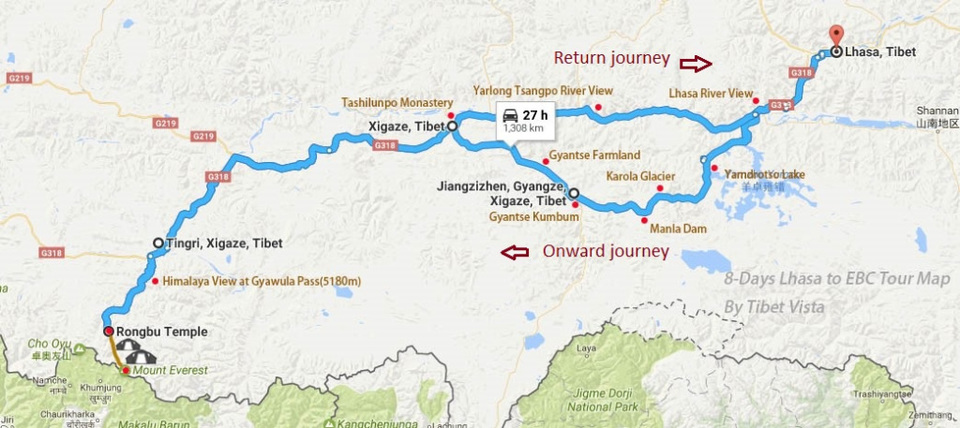
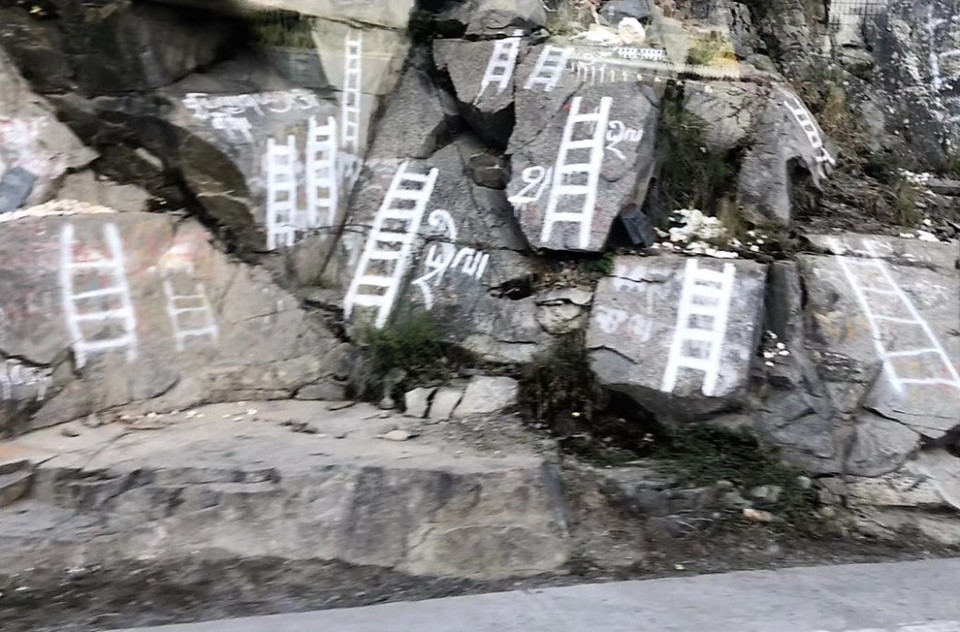
First stop was in about half an hour to see the beautiful view of a place where rivers Yarlong Tsangpo (Brahmaputra) and Lhasa meet. The scenery was beautiful. After spending few minutes here, we moved on and stopped an hour later at a place (Kamba La, or Gangbala Pass, on S307) from where we could see the Yamdrok lake and Mount Nojin Kangsang (7206m). The view of turquoise blue colored lake was breathtaking. We took many pictures. The local people kept lambs and Mastiff dogs for photography with visitors (10RMB for a photo). We got Kavya to pose with lambs. After some time, our bus moved along the lake and we reached the stunning Yamdrok lake. We spent good amount of time here. I also posed for photograph with two huge Mastiffs.



Yamdrok lake is one of the three largest sacred lakes in Tibet the other two being Namtso and Manasarovar. It is in Nangartse County, Shannan Prefecture, at an altitude of 4,441 meters, over 72 km long, surrounded by many snow-capped mountains and is fed by numerous small streams. People believe that Yamdrok Lake is the transformation of a goddess. According to a legend, there were nine lakes. Dakini Yeshe Tsogyal was concerned that creatures in the lake would die if the lake dries. So, she threw 7 liang (~50 grams) of gold in the air, recited a mantra, and changed all the small lakes into a big one. It looked like the shape of iron scorpion held by Padmasambhava.









Another tale of the lake is about a young girl who lived by the lakeshore. She loved to bathe in the lake early in the mornings. A rich man fell in love with her, and hid by the lake one morning, grabbing her as she approached the lake, in order to take her to his home to be his wife. As he stepped out of the water, a fairy appeared, beat the man to death with her beads. But he refused to release the girl, who was dragged to the bottom of the lake with him and drowned. When the villagers came looking for her, a beautiful white bird flew out from the lake, and they found only the body of the rich man. People believed that the fairy had turned the girl into the white bird when she drowned, and ever since, the lake has been home to a wide variety of birds.




Yamdrok Lake also has lot of fish. As Tibetans believe that fish are the incarnations of the god of water, and it is a sin to eat or attack them, it is believed that they should not be caught and eaten. It is widely believed that only demons and evil men will eat fish. On the contrary, with commercial interests taking over the traditional beliefs, there is also fishing happening.
In Tibet, mountains and lakes are considered sacred, and devotees go around the lake to wash away any sins. A ritual walk around the perimeter of the lake, is known as a "kora". It may take three months on foot and up to six months with full body prostrations. This is also one of the holy lakes where the monks and religious leaders seek for the clues to pick the reincarnated new Dalai Lama. Yamdrok is considered as the lifeline of the region and it is said if the lake dries up, Tibet would become an uninhabitable place.
Around 12, we left Yamdrok and the van drove along the lake for some time. We could see lot of sheep as well as black-necked cranes from a distance along the lake shore. We stopped at Nagartse (Nagarzê) for lunch and went to Lhasa restaurant. Hema and Kavya had egg fried rice, while I had egg and vegetable fried rice. I went around after lunch. Nagartse is a small, but beautiful town that serves as a base for people visiting the nearby attractions. This route is famous for cycling and biking tours. It is not far away from Bhutan and Sikkim.
We moved further and the route was getting more scenic due to the ice capped mountains. We made two stops to watch the Kharola glacier, the second one a bit longer.
Kharola glacier (5560m) originates at Mt. Noijin Kangsang which is one of the four holy mountains of Tibet. In Tibetan it is called Khareg La, which means Sky touching mountain pass. There is a stupa, and and a wooden walkway leading to a higher view point. We took some pictures here. We then proceeded further and reached Gyantse (Gyangze) at 17:00. The road had several check posts where Phurbu showed our passports and permits to the authorities. In some check posts, we had to personally see the officers.




A horse back statue of Songtsen Gampo is seen as we enter Gyantse. We stopped near Gyantse Dzong, a hill top castle and took its pictures from a distance. This fortress has a patriotic story. In 1904, British troops invaded Gyangtse and faced a fierce opposition from the strong and brave Gyangtse people. They defended their city from here, using primitive guns and cannons, swords, and even bows and arrows to fight against their aggressors. They could hold the attack for three days, before losing out due to shortage of ammunition. Many of the local people jumped from the mountain to their death. Thus, Gyantse is regarded the city of heroes.


Next, we visited the Pelkor (Palcho) Chode Monastery ("Auspicious Wheel Joy Monastery" in Tibetan language). Surrounded by mountains on 3 sides, the monastery has 4 major parts: Buddhist halls, Bodhi Dagoba (Kumbum Stupa), Zhacang (dormitory) and surrounding wall. Pelkor is unique as it was the place that had three major sects of Buddhism together.


The Main Assembly Hall is a three-storied building, about five hundred years old. On the first floor are the three Chapels and a cloister. A chapel has four-headed Nampa Namse (Vairocana) and the other four Dhyani (or Wisdom) Buddhas. In the Main Chapel is an eight meters high bronze statue of Sakyamuni flanked by the Past and Future Buddhas. It is said that about 14,000 kilograms of copper was used to build the statue. The chapel has many Thangkas paintings. Manjusri Bodhisattva, White Tara and Arhats are enshrined in the chapels on the second floor. The eighteen-Arhat clay sculptures in the Arhat chapel are famous. Amitabha Buddha, Dakinis and murals are displayed in the chapels on the third floor.
The Bodhi Dagoba or Kumbum stupa is the most interesting part of Pelkor monastery. It is ~ 32 meters high. It is a nine-level building with 108 gates and 76 chapels. It is also known as 'Ten Thousand Buddha Pagoda' as about ten thousand figures of Buddha exist there. Fortunately, photography is allowed here with a fee of 10RMB. I and Yinteck, a Malaysian co traveler, visited most of the chapels in the stupa. It was like a wonderland displaying an endless series of different deities. Kumbum means 100,000 images in Tibetan. As many of the chapels were very small and dark, it took some effort to see and photograph the places. It was already beyond 18:00, and Phurbu was looking for us to come back and proceed further. We reluctantly came back.




















It was 20:00 by the time we reached Tashichoeta, our hotel in Shigatse. As we wanted to see a doctor for Hema's altitude sickness, Phurbu took us to the place he knew, but the doctor had already closed for the day. We came back and went to bed. Fortunately she had the tablets given by Kujtim.
Day 4, 4th October, Shigatse to Everest base camp: Obviously this was going to be the most exciting phase of our journey, approximately 354 km distance through winding mountain roads. We left the hotel at 8:30 and took G318, the Sino-Nepal friendship highway. Our first stop, at 10:30, was the landmark 5000 km distance from Shanghai to Zhangmu. There is a monument indicating this remarkable feat of Chinese engineering. A couple of hours later was the Gyatsola mountain stop. The altitude here is 5248m. We did some photography and moved on. Lunch was once again egg fried rice in a small but decent restaurant.




The route had snow covered mountains at a distance and vast grasslands where many Yaks grazed. Phurbu told an interesting story about the Yaks.
Centuries ago, Yak used to live in India. At the time, it did not have the long and thick hair that it now has.
It was believed that Buffalo was Yak's uncle. Buffalo used to have long and thick hair. Yak had heard stories about the beauty of the land of Tibet. He had heard their stories from the Tibetan antelope when a herd of them had come to India. So, he decided to go to Tibet to find out. He started his journey but couldn't succeed, as the road to Tibet was very hard to navigate. It was also unbearably cold. So, he came back to India. But he did still want to go to Tibet. He knew he had to plan well before he tried again. He went to his friends, who had thick fur, for help. It was decided that they all would go to Tibet together. Now he had to get some fur for himself. He went to his uncle to ask for his fur, but his uncle refused. Yak assured him that he would give him his fur back along with lots of salt, once he returned from Tibet.
The next day, at sunrise, they all began their journey. They crossed the Brahmaputra with great difficulty and reached the border between Tibet and India. As they were crossing the river, a pack of wild dogs attached them. But after a long struggle, they fought off the dogs and journeyed on towards southern Tibet, now Lhasa. While crossing some fields, they were caught by a bunch of farmers, who tied them up, making it hard for them to escape. At midnight, managing to break free from their ropes, they ran for their lives. After three days, they reached Lhasa. It was more beautiful than what the antelope had told them. The air, the water and the sky were much cleaner. So, they all decided to stay there forever.
Back in India, as time passed, Buffalo began to realize that his nephew had fooled him. Buffalo then learnt that one must not be gullible. ( https://www.pestalozziworld.com/news/story-yaks-fur)
Over a period, there are many cross breeds of yaks. Yaks crossed with cattle leads to Dzo, which is further crossed with yak or cow leading to different breeds.

The first view of the Everest peak was around 13:30 from the bus. A little later, we stopped at a view point (Tsola Pass, 4600M). The range of the peaks made a spectacular view, but Everest was mostly cloud covered. The next stop was after about three hours, at the Gyawula pass (5180m). This place had a better view of the Everest range, but Everest was till mostly under the cloud. Phurbu shared a picture of the mountain range with the peaks marked with their names. The range had five peaks taller than 8000 meters. Mount Everest (8844 m), Makalu (8463 m), Lhotse (8516m), Cho Oyu (8188 m) and Shishapangma (8027 m). Gyawula pass stop also had some guest houses and toilets (Tibetan toilets, just a hole in the earth). Locals were selling prayer flags. We moved further through very scenic, but very winding roads. The driver certainly was highly skilled.









At 18:20, we crossed the final military check post and We moved from our vehicle to the Eco-friendly buses. Phurbu handed over our Tickets both for base camp and the bus. It took another 25 minutes through the curvy mountain roads to reach the Rongpuk guest house. From the bus, it looked like the could had moved from the Everest peak. Once we reached the guest house, I didn't even wait for a minute and rushed to the site from where people were watching the mighty Mount Everest (Sagarmāthā, Qomolangma" or "Mother Goddess of the Earth" in Tibetan), the tallest mountain in the world!



A few minutes later, when I felt cold, I came to my senses and came back to the guest house and returned to the spot with Hema and Kavya. We were given oxygen canisters and Hema used some. After an hour later, around 19:45, the sun started going down and the golden glow started increasing on the Mount Everest peak. This was clearly one the best sights of our lives, seeing the golden glow of the tallest mountain, in its best possible view! We were fortunate that clouds that had stayed on the peak earlier in the day had been on us and moved away! The atmosphere was surreal and divine. We stayed there till 20:15, soaking in the nature's benevolence, and returned to the guest house. The rooms in the guest house had five beds, heated electrically and four of shared a room. Though there is a restaurant outside, we didn't feel like trying it.


Day 5, 5th October, Everest base camp to Shigatse: Next morning, I went to site around 7:00, it was a bit dark, but the mountain was clear. In the next half and our, cloud started gathering and by 8:15 clouds had fully covered it. By the time we returned, Phurbu and the driver were looking for us. We didn't have time to visit the Rongbu monastery that was in front of the guest house.


We caught the Eco buses and came to the entrance of the Nature reserve, got into our van and left for Shigatse. Once again, the travel through the serpentine road was exciting and we saw a great view of the Everest range for a long time from the bus. We had lunch around 11:30 on the way and tried Kung pao chicken and tomato with egg. We reached Shigatse around 18:00 and checked into the same hotel, Tashichoeta. I and Hema went around and tried eating dinner in a large Tibetan restaurant with very few people. For our disappointment, all kind of communications failed, and we ended up ordering rice with sweet yoghurt and some bun like thing (which we had ordered as Momo's!) which had no taste.



Day 6, 6th October, Shigatse to Lhasa: Shigatse is the second largest city in Tibet and is famous for the Tashilhunpo monastery, the seat of Panchen Lamas. We visited the monastery in the morning as people were tired by long journey the previous evening.
Tashilhunpo Monastery was built in 1447 by Gedun Drupa, the first Dalai Lama. The monastery was sacked when the Gorkha Kingdom invaded Tibet and captured Shigatse in 1791 before a combined Tibetan and Chinese army drove them back to Kathmandu and forced them to agree to keep the peace in the future, pay tribute every five years, and return the loot.

Tashilhunpo is one of the five most sacred monasteries in Tibet and is famous for the 26.2 meters high Maitreya (future buddha) statue. It is said that the 9th Panchen lama collected taxes for expanding the military but decided to use for religion and spent it on the Maitreya. The statue was handcrafted by 900 craftsmen in 9 years. The lotus seat is 3.8 meters. It is estimated that 279 kg of gold and 230000 kg of copper was used for making the statue, supposed to be largest of this kind. It is adorned with precious stones. The statues of Avalokitesvara and Manjusri Bodhisattva created by the First Dalai Lama are close by. The surrounding walls have 1000 more gold paintings of Sakyamuni in different postures and expressions. The ceiling of the chapel is painted with a Kalachakra (Dukhor in Tibetan) mandala. This building, the Kelsang temple, also has a 5 meters high statue of Sakyamuni. It is said that a part of Sakyamuni's relics was placed in it. In an adjacent chapel a White Tara is flanked by two Green Taras.





Another feature is the Thangka wall, where large Thangka paintings are displayed during the festivals. Many places have the photos of the ninth, 10th and 11th Panchen Lamas. 11 th is the latest, supposed to be residing in Beijing. Photography is allowed in the chapels, at the cost of 125 yuans!
The monastery is famous for stupa tombs and places of Panchen Lamas. They are known to hold the bones and remains of the sacred lamas. The tomb of the 10th Panchen Lama (Serdung Sisum Namgyel) is a dazzling gold-plated tomb inside the Victory Chapel (Namgyel Lhakhang). A statue of the 10th Panchen Lama Choekyi Gyaltsen, who died in 1989, is displayed atop the tomb. The gold-roofed chapel Kundun Lhakhang holds the tomb of the fourth Panchen Lama Lobsang Choekyi Gyeltsen (1567-1662), close associate and teacher of the fifth Dalai Lama. The 4th Panchen lama was an expert in other schools too. Thus, his statue has a lotus hat and not a regular yellow cone. The tombs of 5th to 9th Panchen Lamas are together. They were built by the 10th Panchen Lama to replace those destroyed in the Cultural Revolution.

Legends state that there are many underground tunnels connecting the Tashilumpo Monastery with Shambhala (also referred to as Shangri-La, a mythical kingdom, said to be laid out in precisely the same form as an eight-petalled lotus blossom surrounded by a chain of snow mountains) and it is an accepted truth that certain incumbent Panchen Lamas have physically traveled there over the course of hundreds of years.




The outer walls of the chapels have many interesting paintings and murals. The eight auspicious symbols (the parasol, two golden fish, the conch shell, lotus, the banner of victory, the vase, the dharma wheel, or dharmachakra and the eternal knot) and three mythical animals (the snow Lion, Naga or dragon and Zeeba or Zipak) and other paintings are beautifully displayed. Phurbu explained different parts of a dharmachakra with great details. We finished the monastery visit at 10:30 and proceeded further. We took the shorter route from Shigatse to Lasha. In some places the ride was bumpy due to the road works, as the road was badly damaged due to floods on Brahmaputra last year.
Around 12:30, we stopped at Dazhuka (3700 m) for lunch 12:33. Enhui helped us to select and we chose a vegetable, chicken dish that took quite long to arrive. Next. we stopped at 16:30 for a river view before reaching our hotel in Lhasa at 18:00. Some of the team members were going to continue for couple of days more. We thanked the driver and Phurbu and parted from the group. That evening, we three went around and visited a large market on Beijing street that sold jewelry, accessories, handicrafts, carpets, tapestries, thangka and other things. We also tried some lamb skewers at a Xinjiang restaurant that was good. On the way back we tried local ice cream. I bought a winter jacket in one of the shops.



Day 7, 7th October, Lhasa to Beijing: This was our last day. We were on our own. As the flight was in the evening, I thought we will visit the Norbulingka summer palace. We took a taxi from the hotel to Noubulingka.
Norbulingka means "Treasure Park" or "Jewel garden" in Tibetan. It was built in 1751 by the seventh Dalai Lama Kelzang Gyatso. It is said that he was ill in his later years and physicians advised him to live in Norbulingka and have a bath there with running water to preserve his health. Following this advice, he stayed in Norbulingka every summer until he passed away. It underwent many expansions in the next 200 years and has been the summer palace of the successive Dalai Lamas. It is a large garden with chapels, gardens, fountains and pools.


The entry ticket costs 60RMB each and looked impressive with a 3D pattern. As the area looked large, and we didn't have much time, we took a buggy by paying 20RMB. The buggy driver gave a slip with a telephone number to be called once we finished each place. First stop was at the Kalsang palace, named after the 7th Dalai Lama. It is a three-story building with halls for worshipping Buddha, bedrooms, reading rooms and sanctuaries. It is surrounded by a beautiful garden. After finishing seeing this, I called the buggy and the driver dropped us to Chensel Podrang (palace).


Chensel Podrang was built in 1922 for the 13 th Dalai Lama. It has a throne and a silver statue of the 13 th Dalai Lama and houses the statues of three Longevity Buddhas. The murals depict stories of Sakyamuni and Tsongkapa.


Next was Dadan Mingjur palace (Takten Migyur Podrang) meaning "Eternal Palace", built by the 14 th Dalai Lama in 1954. It is also called the New Palace and is the most luxurious. The assembly hall has magnificent gold throne and wall paintings depicting all Dalai Lamas. Along with the features of the palace, it has murals depicting the story of Sakyamuni as well as history of Tibet.



Norbulingka has a Thang ka museum, that was closed. The garden is very impressive. We spent some time in the garden and returned to our hotel by taxi, crossing the Potala palace again. We caught the shuttle to airport at 12:00 and reached Lhasa Gongga airport after an hour. Our flight to Yinchuan was at 17:00 and the one from Yinchuan was at 22:50. As the two flights belonged to different airlines, we had to take out our bags at Yinchuan and check in again. It took some time for me to understand this with the help of Xiaotuo.
We had lunch at the airport, rested for some time and boarded the Tibet airlines flight to Yinchuan. We reached Yinchuan at 19:40, collected our bags and moved to the second floor for the next flight. Yinchuan is the capital of the Ningxia Hui, and the airport was big with many flights operating. We flew with Xiamen Airlines and reached Beijing PEK terminal 2 at 00:45. It was 02:30 by the time we reached home.
Though planned in a hurry, the Tibet trip was wonderful as we got to witness so many beautiful places in a week's time. Visiting the Mount Everest northern base camp and watching the marvel from so close was indeed highlight of the trip. The blog is long due to the Buddhist legends, but I feel it is wonderful world of mythology. Thanks to Phurbu for being such a nice guide and the driver who drove the vehicle so well. Phurbu also went through the blog in detail and helped to correct some facts. Thanks to the teammates and FCN Evelyn and Xiaotuo for the help with planning and booking.

